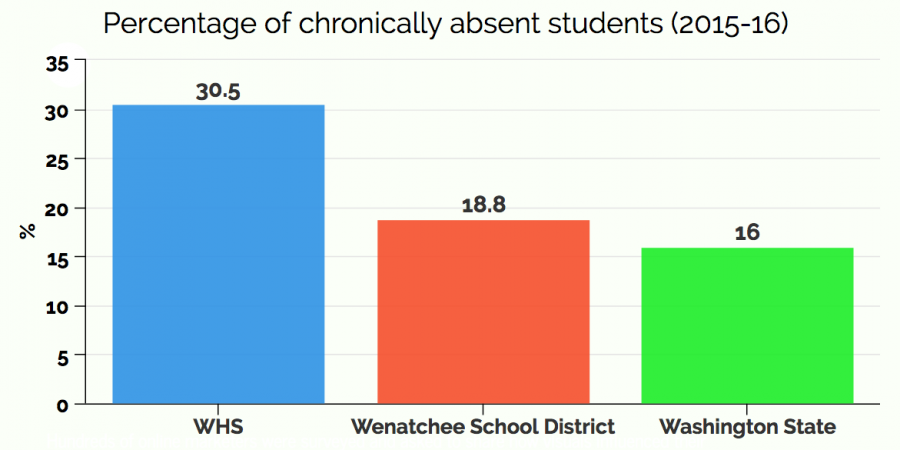Graphic by Moses Lurbur
Chronic absences affecting student performance
February 16, 2017
It may seem obvious that academic success in school is contingent upon attendance. However, many WHS students are chronically absent, habitually missing enough school to fall behind in classes, perform lower on tests, and ultimately, risk not graduating high school.
Chronic absence is defined by attendenceworks.org as a student missing 10 percent (18 days out of 180) or more of a school year for any reason, including excused and unexcused absences, school activities, sports, disability, or illness. Chronic absence should not be confused with truancy, which addresses unexcused absences only. Truancy deals with compliance with the law. Conversely, it is acknowledged that the issues of homelessness, illness, mental health and unreliable transportation that account for chronic absence are reasons to be sympathized with.

In Washington state, 16 percent of students enrolled in public school at all grades were chronically absent for the 2015-16 school year, and the Wenatchee School District’s chronic absence rate was 18.8 percent according to the Office of Superintendent Public Instruction. Wenatchee High School’s absentee rates run higher over the past three academic years. 33.9 percent of students were chronically absent during the 2014-15 academic year. From 2015-16 and 2016-17, chronic absence rates were 30.5 percent and 31.8 percent respectively (the 2016-17 statistic shows the number of students who have missed 10 days thus far because we are roughly 100 days into this academic year. So currently, 31.8 percent of WHS students are on track to be chronically absent by the end of the year). Though these numbers may seem startlingly higher than the state average, it is important to note that the state average includes all grade levels whereas WHS includes only grades 9-12. High school students are chronically absent at a higher rate than younger students in all parts of the state, not just in Wenatchee.
How do those numbers affect students further down the road? A study published in 2007 by the Consortium on Chicago School Research at the University of Chicago found a strong correlation between absentee rates and graduation rates. In the study, only 21 percent of students who missed between 15 and 19 school days per year graduated high school in four years; that number dropped to 19 percent for students who missed 20-24 days per year.
For the 2015-16 school year, 78.1 percent of Washington state seniors graduated on time compared to 81.3 percent graduating on time at Wenatchee High School.
It is important to understand that chronic absence and the problems it creates for students doesn’t just appear in high school, but rather, is a continuation of habits or issues that begin as early as pre-k for many students. The aforementioned Chicago study found that 40 percent of pre-k students were chronically absent in the district, which in turn lead to lower kindergarten readiness scores and first and second grade test scores for those students.
Chronically absent middle school students were very likely to be off track to graduate high school. Middle school students missing 15-19 days of school per year failed four classes on average, and 65% of those students were on track to not graduate in four years. It was also revealed that student absences nearly doubled from 8th to 9th grade (from 8.4 days to 16.5 days missed per year on average), and that chronically absent student GPAs dropped half a point on average from 8th to 9th grade.
At Wenatchee High School, there are many programs in place to provide chronically absent students with the help they need to improve their attendance and increase their chances for success in high school. Given that there are countless, complex reasons for a student to be chronically absent, the services and programs put in place at WHS to help those students are just as varied. For example, students who lack reliable transportation to and from school are given free bus passes. If a student’s schedule is overwhelming to the point that he or she stops coming to school, it can be changed, or the student can discuss options of attending the Tech Center or Westside High School for a more meaningful, smaller school environment. Credit retrieval is available to students who miss enough school to fail courses and fall behind in credits needed for graduation. The Homework Center is also available for students after school if they need tutoring for specific classes.
Students suffering from anxiety or other mental health problems can be directed to behavioral health services at Confluence Health and Catholic Family and Child Services through WHS. WHS also connects students to other supportive community organizations such as parent mentor programs, suicide services, Strengthening Families workshops, and the Wraparound with Intensive Services (WISe) program.
Junior Rebecca Devereaux understands the detrimental consequences that decreased attendance has on academic performance.
“It’s really hard to make things up that you miss when being absent, so I try to miss as little class as possible. I don’t understand how people who are consistently absent can do well in class,” she said.
English teacher Jennifer Netz has encountered many chronically absent students throughout her years of teaching, each with their unique circumstances and struggles that harm their school attendance.

“There are so many reasons for students to be vulnerable to absences,” she said. “Some kids have to leave the country for weeks out of the year and it’s not their fault…I’ve had students who have experienced emotional trauma and assault…we need to be open to working with these kids instead of assuming that [chronically absent students] are lazy or don’t care.”
Netz is pleased with recent changes that WHS staff have made with regard to helping chronically absent students.
“In the past I’ve taught at schools where teachers would openly express happiness if a student was absent. [At WHS] the deans communicate with staff really well. We have forms to fill out if we are concerned [about a chronically absent student] and that improved outreach helps clear up what’s going on. I’m proud of the outreach changes that have happened since Mr. Anderson’s [arrival to WHS]”.
Netz does her best to keep a line of conversation open with students who are absent for an extended period of time so that they can keep up with classwork.
“It’s hard to recreate class discussions…I have conversations with students when they return or ask them to keep a journal if we’re reading a novel in class. All situations are unique, though. It doesn’t always work out.”
“It’s important that kids know that helpful services at WHS are available to them. Try not to be afraid to ask for help,” she said, “help us help you.”

